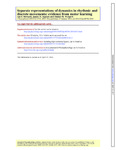Separate representations of dynamics in rhythmic and discrete movements: evidence from motor learning
| dc.contributor.author | Howard, IS | |
| dc.contributor.author | Ingram, JN | |
| dc.contributor.author | Wolpert, DM | |
| dc.date.accessioned | 2016-06-02T12:04:22Z | |
| dc.date.available | 2016-06-02T12:04:22Z | |
| dc.date.issued | 2011-04 | |
| dc.identifier.issn | 0022-3077 | |
| dc.identifier.issn | 1522-1598 | |
| dc.identifier.uri | http://hdl.handle.net/10026.1/4800 | |
| dc.description.abstract |
<jats:p> Rhythmic and discrete arm movements occur ubiquitously in everyday life, and there is a debate as to whether these two classes of movements arise from the same or different underlying neural mechanisms. Here we examine interference in a motor-learning paradigm to test whether rhythmic and discrete movements employ at least partially separate neural representations. Subjects were required to make circular movements of their right hand while they were exposed to a velocity-dependent force field that perturbed the circularity of the movement path. The direction of the force-field perturbation reversed at the end of each block of 20 revolutions. When subjects made only rhythmic or only discrete circular movements, interference was observed when switching between the two opposing force fields. However, when subjects alternated between blocks of rhythmic and discrete movements, such that each was uniquely associated with one of the perturbation directions, interference was significantly reduced. Only in this case did subjects learn to corepresent the two opposing perturbations, suggesting that different neural resources were employed for the two movement types. Our results provide further evidence that rhythmic and discrete movements employ at least partially separate control mechanisms in the motor system. </jats:p> | |
| dc.format.extent | 1722-1731 | |
| dc.format.medium | Print-Electronic | |
| dc.language | en | |
| dc.language.iso | eng | |
| dc.publisher | American Physiological Society | |
| dc.subject | interference | |
| dc.subject | rhythmic movements | |
| dc.subject | human | |
| dc.title | Separate representations of dynamics in rhythmic and discrete movements: evidence from motor learning | |
| dc.type | journal-article | |
| dc.type | Article | |
| plymouth.author-url | https://www.ncbi.nlm.nih.gov/pubmed/21273324 | |
| plymouth.issue | 4 | |
| plymouth.volume | 105 | |
| plymouth.publication-status | Published | |
| plymouth.journal | Journal of Neurophysiology | |
| dc.identifier.doi | 10.1152/jn.00780.2010 | |
| plymouth.organisational-group | /Plymouth | |
| plymouth.organisational-group | /Plymouth/Faculty of Science and Engineering | |
| plymouth.organisational-group | /Plymouth/Faculty of Science and Engineering/School of Engineering, Computing and Mathematics | |
| plymouth.organisational-group | /Plymouth/REF 2021 Researchers by UoA | |
| plymouth.organisational-group | /Plymouth/REF 2021 Researchers by UoA/UoA11 Computer Science and Informatics | |
| plymouth.organisational-group | /Plymouth/Users by role | |
| plymouth.organisational-group | /Plymouth/Users by role/Academics | |
| dc.publisher.place | United States | |
| dc.identifier.eissn | 1522-1598 | |
| dc.rights.embargoperiod | Not known | |
| rioxxterms.versionofrecord | 10.1152/jn.00780.2010 | |
| rioxxterms.licenseref.uri | http://www.rioxx.net/licenses/all-rights-reserved | |
| rioxxterms.type | Journal Article/Review |


